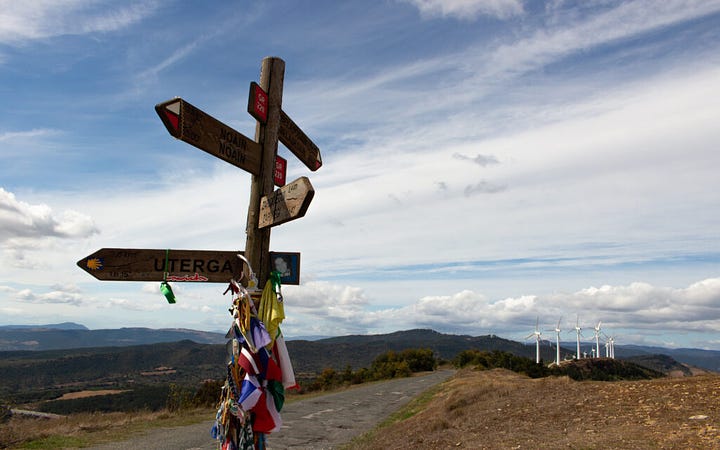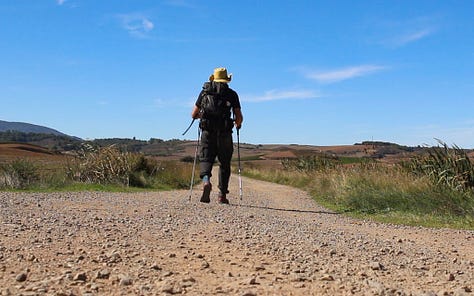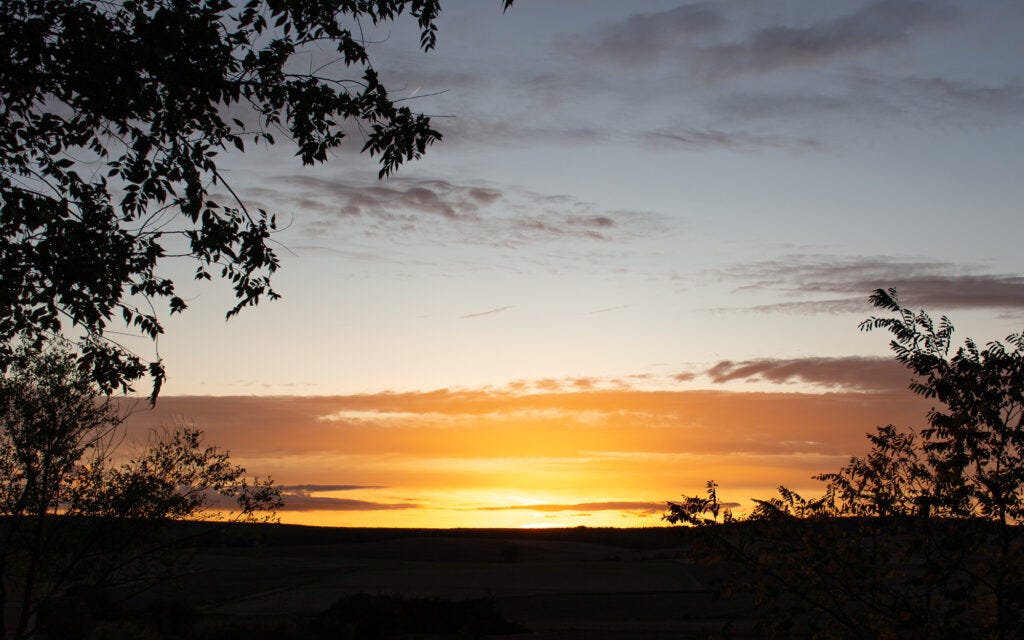The Camino de Santiago Part 2: Navarra
…continued from Part 1: The Pyrenees
I start west in the morning after a passing rainstorm. The way out of Pamplona is well marked, either by yellow arrows or the famous Camino shell, which can be found on signs throughout the pilgrimage. The story is that pilgrims would reach Santiago de Compostela and receive a scallop shell to wear on their journey home as proof that they reached the end. Over time, it became the official symbol of the Camino, and can commonly be found on trail markers, in churches, at souvenir shops, or on the backpacks of pilgrims. I reach an intersection in western Pamplona expecting to see one. “Puedes ver la señal del Camino por allá,” a lady behind me says, pointing at the seashell emblem engraved on a sidewalk tile, marking the way out of the city.
I spend two hours hiking past the outskirts of Pamplona before starting an ascent up the barren ridge of Alto de Perdon. When I reach the summit, I find an incredible panorama marked by famous sculptures of pilgrims. I look back and see the sprawling city in the east. To the north are the jagged mountains of the Basque Country. And in the west is the way of the pilgrim, crossing into a vast plain and beyond. I look out at the western horizon, where Santiago and the ocean feel like a lifetime away. But I don’t need to think about it right now. I just need to get down the mountain.


I pass three towns that afternoon, exhausted in the late day. It is at its hottest part of the day from mid to late afternoon, and I realize why most people start at daybreak and finish around 2:00. When I reach Puente la Reina, I hike a painful quarter mile through the town to my hostel. The blinding sun feels like it’s trying to push me backwards. A cute Spanish girl passes and says “Buen Camino!” which is a welcome and encouraging distraction from the hot, blistering afternoon. I finally check into my hostel and look for the first restaurant I can find.
Learning my lesson, I set out the next morning at daybreak. I soon reach the town of Estella, which feels secluded by three different hillsides. After another foot assessment I realize I’ve been hiking out here for a week and have yet to develop a single blister. If a seasoned backpacker knew this, they would tell me that my foot strategy is working. In other news, this is a picture of me getting unvirgined to paellas:
I leave early the next morning, joining a group of Koreans leaving the city. Out of nowhere we reach the Fuente de Vino. I completely forgot about this fucking place. Agua or vino? You decide!
The land going out of the Navarra region is an old landscape, where to the westbound pilgrim the mountains will eventually change into rolling hills, some with hilltop castles in the distance. Much here has moved on, but many old, crumbling buildings remain to this day. Each day I walk through the country, cresting the hills and looking out at the surrounding towns. My Camino begins to feel like a dream – a timeless and stateless and perhaps even endless trek, always with one more seashell or yellow arrow to guide me onward. The kindness of the common folk and the pilgrims, and the transient nature of the Camino itself, are forcing me into a state of mind without any regard to time or attachment. With each grinding step on the gravel, each hillside town, each dinner at a plaza restaurant with new friends, and each sunrise from a new day, this road is becoming my own Camino – mine among other wanderers, each with their own story.
I meet Leah and Greg, a couple from Cleveland just outside of Logroño after an especially hard day. They invite me to watch a bull fight that evening. I tell them thanks, but the idea of slaughtering an animal in front of a cheering crowd doesn’t seem very appealing. Instead, I walk around the centre during a big city wide festival. I run into the Brazilian peregrinas, Maria and her mom, and we find a good pinchos restaurant a couple blocks from the main plaza. It’s basically a butcher shop where they grill all kinds of meats on demand. The thick bacon was especially good.









I leave Logroño the next morning on a well maintained bike trail out of the city. Villages come and go in a blur, many with their own unique story, like the lovely Torres del Rio, which translates to Towers of the River. In Belorado, I hike the main street until I reach this landmark left behind by Martin Sheen ten years ago when he filmed The Way.
Then there was the cathedral on a hilltop above Santovenia, where I come out to see the sunrise for the simple reason that the sunset the night before was just as amazing. It is the thirteenth and last day of this stage. I clear one final ridge that day and see the city of Burgos sprawling across the valley ahead. After three more shitty hours hiking past the airport and along the main highway into the city, I finally reach the magnificent Burgos Cathedral, marking the end of my second stage of the Camino.


I was paranoid for the longest time that this trip would get derailed by blisters or something worse. But after checking my feet in Burgos, I note that I didn’t get a single blister the entire time. No problems with soreness or swelling either. My feet are at 100%.
It’s the shoes. I used the the Altra Lone Peak Mid model, namely for the soft cushioned insoles and outer traction that work so well on hard, flat surfaces. For many backpackers, it comes down to a lot of trial and error before they find out for themselves what the best footwear strategy is for long-term hiking. When they figure it out, it is often just a short list of things that work uniquely for them. For me, it was Altra shoes, Injinji toe socks, a thin merino wool outer layer, and a gel toe cap to cover a chronic callus on my fourth right toe. The bastard toe. The one I’ve had since I was a teenager and could never for the life of me get rid of. Usually it is the first thing on my feet to give me trouble when I go hiking. But even that turned out okay.
Unfortunately, I can’t hike any further at this time. I don’t have enough vacation hours left for the remaining four weeks of the trek, and I will have to save them up and continue in the future. But this stage was never really about completing the Camino, it was about answering the question that drove me crazy for years: Can I really do this? Now I realize that not only can I hike this trail, but I can kick ass at it.
I leave on a bus for Madrid the next day. I think about how the last two weeks went by in a flash, and I’m not yet sure how I feel about it. As the bus departs from the city, I think back to the evening I spent at a small aubergue in Viloria three nights ago.
The host family made a pilgrim dinner for me and two other hikers. There was Ivan, a loud, opinionated fellow who started his Camino from his home in Belgium. And Catherine, a recently retired woman from North Carolina who just started her Camino for the first time. And then there was me, the guy from Chicago with all of the drive in the world and no understanding of why.
The wife, an abuela originally from Italy, told us that she had lived in the town for twenty years, and watched the Camino change a lot as it became a popular trail all over the world. And while others like Ivan and I weren’t as interested in how commercialized it was getting, she didn’t seem to mind. Because to her, the Camino is for everyone. And each person can find their own path, no matter what was or wasn’t.
I was almost about to leave the next morning when she came over to wish me farewell. She told me that I must walk the path for myself, and I must find my own Camino. I don’t remember exactly how she said it, but I do remember the kindness of the person behind it. And to be completely honest, I still don’t know what I was doing out there, or why that trail matters to me so much. I went through a lot of fucking trouble to get there, but the reasons for it are not something I can put into words. And while I may not know yet what it means to “Find my Camino”, with each new day maybe I can.
The bus continues south through the Spanish countryside. I’m an hour outside of Madrid, where I look forward to a few days of rest and good food. I look out at the passing hills as we approach the city, thinking back to an old road that goes across Spain, where many unforgettable stories have only just begun. And whether I’m hiking across the formidable Pyrenees Mountains, sharing tapas and wine with pilgrims in the bustling city centres, crossing an endless Meseta among the kindred spirits on the trail, casting a lifetime of burdens at the foot of Cruz de Ferro, or watching a golden sunset on the shores of Cape Finisterre, there is no question to me that there is something wonderful and cathartic about the Camino de Santiago.
This isn’t over.
This story continues on the Meseta.








